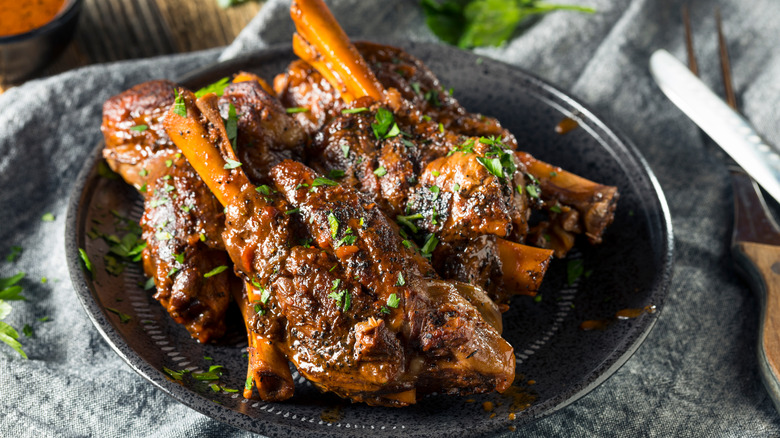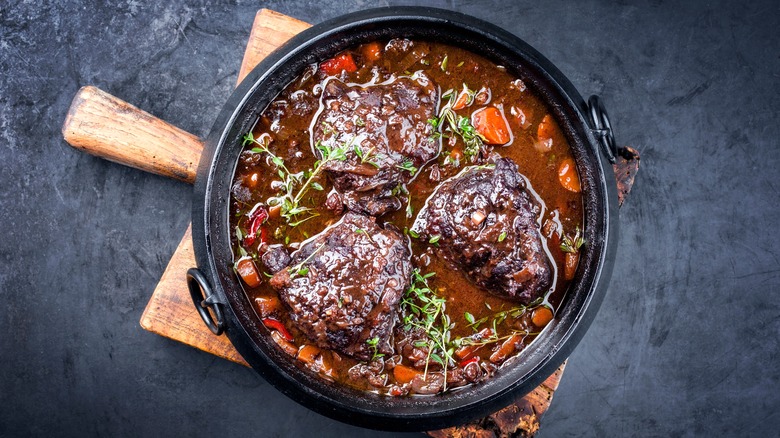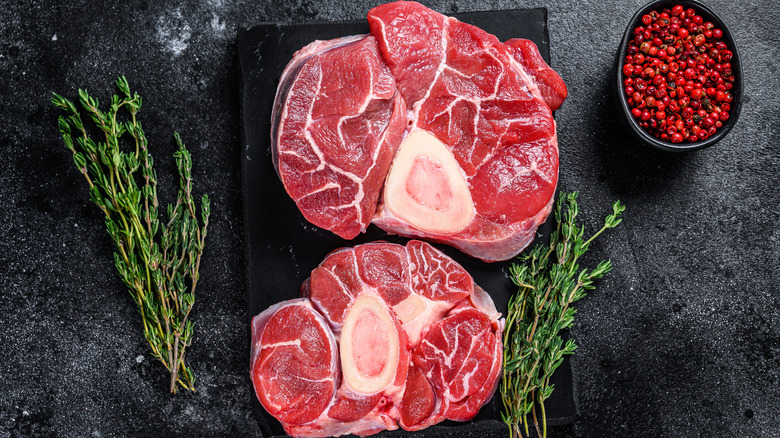Cuts Of Meat That Braise Well Have One Common Characteristic
Braised meats and vegetables seem to belong to the winter when long and low cooking warms the house and fills the short hours of the day. But one shouldn't feel beholden to seasonal cooking trends; A summer braise can be just as soul-satisfying as one with a snowy backdrop. Chicken thighs, beef short ribs, lamb shanks, and pork shoulder all seem pre-destined for slow, moist cooking. But, what is it about these cuts of meat from disparate animals that makes them so perfect for braising? While each cut of meat brings its unique qualities to the table, there is one common characteristic that makes them all exceptional choices for braising.
Cuts such as beef chuck, pork butt, and lamb shanks are rather tough when cooked quickly due to an abundance of connective tissues. These are composed of collagen, a protein that breaks down during the braising process. As collagen dissolves, it enriches the cooking liquid with a luscious texture and imparts a rich, velvety mouthfeel to the meat. Along with all that connective tissue, these tough cuts tend to have abundant marbling, or intramuscular fat, which ensures a moist and tender end result. The fat renders during the braising process, contributing to the overall flavor and succulence of the dish. The higher fat content also helps prevent the meat from drying out during the extended cooking time.
Braising basics for tough cuts
Before braising, it is crucial to sear the meat in a hot pan or Dutch oven. Searing creates a brown crust on the surface via the Maillard reaction, which enhances the flavor and texture of the final dish. It also adds depth and complexity to the braising liquid. For certain braised dishes like pot roast, the meat may be coated in flour before searing — this will further aid the browning and help thicken the braising liquid for use as a sauce.
Next, it is important to remember that tough cuts need to be cooked over low heat for an extended period. This allows that collagen to break down and transform into gelatin, which gives the final dish an unctuous mouthfeel. For this, even heating is needed, and while you can braise on the stovetop, using a heavy-lidded vessel placed in a low-temperature oven ensures balanced cooking.
The braising liquid also plays a vital role in enhancing the taste of the dish. Common choices include broth, wine, beer, or even milk. These liquids do double duty as they infuse the meat with their flavors while providing moisture.
In addition, the slow cooking process allows the meat to absorb other flavors. Adding vegetables like a classic mirepoix, hearty herbs like rosemary and sage, and warm spices such as cinnamon and black pepper helps round out the dish by expanding its flavor profile.
Tough, but cheap
While a general toughness is a tie that binds cuts of meat that do well when braised, you will notice another commonality when you head to the supermarket or butcher's shop to select a piece of meat. Most of these cuts are relatively affordable due to the fact that they are so tough and require a longer investment of time to properly cook. Just compare the price of a pork shoulder, which currently averages between $5 to $8 per pound, to that of pork tenderloin, which can be closer to $13 per pound.
There are also many "forgotten" tough cuts that do quite well when braised. Commonly used in Jamaican cuisine but popular around the world are oxtails. In reality, these come from cattle, but they are joints from the tail, which works hard. Thus, these smaller pieces of meat break down beautifully and the large bone enriches the braising liquid with marrow. Sticking with the cow, beef cheeks are another tough cut that can be seared and braised. The fact that it doesn't include a bone may appeal to some people, though it does nothing to diminish flavor. And, pork belly, when not made into bacon, can be seared off and braised. Its greater fat content makes it a decadent treat.
Once you've got the hang of braising tough cuts, experiment with the elements by swapping in different cuts of meat, braising liquids, and ingredients to make a hearty braised dish that is all your own.


